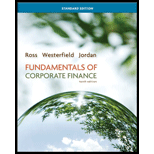
Fundamentals of Corporate Finance Standard Edition
10th Edition
ISBN: 9780078034633
Author: Stephen Ross, Randolph Westerfield, Bradford D. Jordan
Publisher: MCGRAW-HILL HIGHER EDUCATION
expand_more
expand_more
format_list_bulleted
Question
Chapter 2, Problem 2.4CTF
Summary Introduction
To critically think about: The type of cash flow that includes interest expense.
Introduction:
Cash flow refers to the difference between the cash that comes into the business and the cash that goes out of the business. The following are the different types of cash flows in a corporation:
- Cash flow from assets:
It refers to difference between the revenues from the sale of assets and the money invested in purchasing the assets.
- Cash flow to creditors:
It refers to the interest paid to the creditors minus the net fresh debt borrowed by the company.
- Cash flow to stockholders:
It refers to the dividend paid to the shareholders of the company minus the fresh equity raised by the company.
- Operating cash flow:
It refers to the cash flow from operating activities of the firm.
Expert Solution & Answer
Want to see the full answer?
Check out a sample textbook solution
Students have asked these similar questions
What is a problem statement outline? Could you please give seome examples?
What are the research questions and methodology? How do they work, please some examples?
What is a research framework outline? Please give some examples.
What is a Final Research Concept? Please give some example.
Skip Stephens is trying to decide whether it would be wise to consolidate his debt by borrowing funds from Syndicated Lending, a firm that he doesn’t know much about. Syndicated is an Internet lender that doesn’t post much information about the costs of the loans it offers. Some of the additional information Skip has gathered from various sources suggests the Syndicated might use such unethical practices as “bait and switch” to attract customers.
Discussion questions:
Is there an ethical problem? If so, what is it?
What are the implications if Skip borrows from Syndicated?
Should Skip borrow from Syndicated?
9-15
Chapter 2 Solutions
Fundamentals of Corporate Finance Standard Edition
Ch. 2.1 - Prob. 2.1ACQCh. 2.1 - What is liquidity? Why is it important?Ch. 2.1 - What do we mean by financial leverage?Ch. 2.1 - Explain the difference between accounting value...Ch. 2.2 - What is the income statement equation?Ch. 2.2 - Prob. 2.2BCQCh. 2.2 - Why is accounting income not the same as cash...Ch. 2.3 - What is the difference between a marginal and an...Ch. 2.3 - Do the wealthiest corporations receive a tax break...Ch. 2.4 - Prob. 2.4ACQ
Ch. 2.4 - Prob. 2.4BCQCh. 2.4 - Why is interest paid not a component of operating...Ch. 2 - What types of accounts are the most liquid?Ch. 2 - What is an example of a noncash expense?Ch. 2 - The marginal tax rate is the tax rate which...Ch. 2 - Prob. 2.4CTFCh. 2 - Prob. 1CRCTCh. 2 - Accounting and Cash flows [LO2] Why might the...Ch. 2 - Prob. 3CRCTCh. 2 - Operating Cash Flow [LO2] In comparing accounting...Ch. 2 - Prob. 5CRCTCh. 2 - Cash Flow from Assets [LO4] Suppose a companys...Ch. 2 - Prob. 7CRCTCh. 2 - Net Working Capital and Capital Spending [LO4]...Ch. 2 - Prob. 9CRCTCh. 2 - Prob. 10CRCTCh. 2 - Prob. 11CRCTCh. 2 - Earnings Management [LO2] Companies often try to...Ch. 2 - Prob. 1QPCh. 2 - Prob. 2QPCh. 2 - Prob. 3QPCh. 2 - Prob. 4QPCh. 2 - Prob. 5QPCh. 2 - Prob. 6QPCh. 2 - Prob. 7QPCh. 2 - Prob. 8QPCh. 2 - Prob. 9QPCh. 2 - Prob. 10QPCh. 2 - Prob. 11QPCh. 2 - Prob. 12QPCh. 2 - Prob. 13QPCh. 2 - Prob. 14QPCh. 2 - Prob. 15QPCh. 2 - Prob. 16QPCh. 2 - Prob. 17QPCh. 2 - Prob. 18QPCh. 2 - Prob. 19QPCh. 2 - Prob. 20QPCh. 2 - Prob. 21QPCh. 2 - Prob. 22QPCh. 2 - Net Fixed Assets and Depreciation [LO4] On the...Ch. 2 - Prob. 24QPCh. 2 - Prob. 25QPCh. 2 - Prob. 26QPCh. 2 - Prob. 1MCh. 2 - Prob. 2M
Knowledge Booster
Similar questions
- 9-5arrow_forwardEnds Mar 30 Discuss in detail, (Compare and Contrast), the various capital-budgeting tools explained in the chapter. (Payback period, Discounted Payback period, Net Present Value, Internal Rate of Return and Profitability Index). 0arrow_forwardEnds Mar 30 Discuss in detail what is Free Cash Flows and how is it calculated. Also define what is a Sunk Cost as well as an Opportunity Cost. 0arrow_forward
- Subscribe Explain in detail what is a firm's Capital Structure? What is and how does a firm's Financial Policy impact its Capital Structure? Finally, what is opportunity costs and how does it affect a firm's Capital Structure?arrow_forwardWhat is the answer of this finance wuarrow_forwardSolve this finance problarrow_forward
arrow_back_ios
SEE MORE QUESTIONS
arrow_forward_ios
Recommended textbooks for you
 Intermediate Accounting: Reporting And AnalysisAccountingISBN:9781337788281Author:James M. Wahlen, Jefferson P. Jones, Donald PagachPublisher:Cengage Learning
Intermediate Accounting: Reporting And AnalysisAccountingISBN:9781337788281Author:James M. Wahlen, Jefferson P. Jones, Donald PagachPublisher:Cengage Learning Intermediate Financial Management (MindTap Course...FinanceISBN:9781337395083Author:Eugene F. Brigham, Phillip R. DavesPublisher:Cengage Learning
Intermediate Financial Management (MindTap Course...FinanceISBN:9781337395083Author:Eugene F. Brigham, Phillip R. DavesPublisher:Cengage Learning


Intermediate Accounting: Reporting And Analysis
Accounting
ISBN:9781337788281
Author:James M. Wahlen, Jefferson P. Jones, Donald Pagach
Publisher:Cengage Learning

Intermediate Financial Management (MindTap Course...
Finance
ISBN:9781337395083
Author:Eugene F. Brigham, Phillip R. Daves
Publisher:Cengage Learning